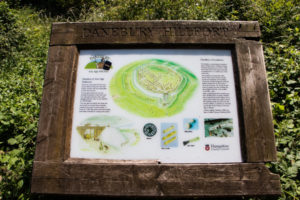Kit’s Coty is a chambered long barrow near the village of Aylesford in the southeastern English county of Kent. Constructed circa 4000 BCE, during the Early Neolithic period of British prehistory.
The name “Kits Coty” allegedly means “Tomb in the Forest” according to signs at the site, possibly related to the Ancient British *kaitom, later *keiton, meaning “forest”.
The Early Neolithic was a revolutionary period of British history. Between 4500 and 3800 BCE, it saw a widespread change in lifestyle as the communities living in the British Isles adopted agriculture as their primary form of subsistence, abandoning the hunter-gatherer lifestyle that had characterized the preceding Mesolithic period. This came about through contact with continental societies, although it is unclear to what extent this can be attributed to an influx of migrants or to indigenous Mesolithic Britons adopting agricultural technologies from the continent. The region of modern Kent would have been a key area for the arrival of continental European settlers and visitors, because of its position on the estuary of the River Thames and its proximity to the continent.
Britain was largely forested in this period; widespread forest clearance did not occur in Kent until the Late Bronze Age (c.1000 to 700 BCE). Environmental data from the vicinity of the White Horse Stone, a putatively prehistoric monolith near the River Medway, supports the idea that the area was still largely forested in the Early Neolithic, covered by woodland of oak, ash, hazel/alder, and Maloideae. Throughout most of Britain, there is little evidence of cereal or permanent dwellings from this period, leading archaeologists to believe that the Early Neolithic economy on the island was largely pastoral, relying on herding cattle, with people living a nomadic or semi-nomadic life.
The surviving part of the monument represents three stones covered by a capstone. The H-shaped entrance to the tomb survives. It is made of sarsen (a fine-grained, crystalline sandstone) and consists of three orthostats supporting a horizontal capstone. The front part of the chamber, as well as a possible façade, is now gone.
Medway Megaliths
The construction of long barrows and related funerary monuments took place in various parts of Europe during the Early Neolithic.
Across Western Europe, the Early Neolithic marked the first period in which humans built monumental structures in the landscape. These structures included chambered long barrows, rectangular or oval earthen tumuli which had a chamber built into one end. Some of these chambers were constructed out of timber, although others were built using large stones, now known as “megaliths”. These long barrows often served as tombs, housing the physical remains of the dead within their chamber. Individuals were rarely buried alone in the Early Neolithic, instead of being interred in collective burials with other members of their community. These chambered tombs were built all along the Western European seaboard during the Early Neolithic, from southeastern Spain up to southern Sweden, taking in most of the British Isles; the architectural tradition was introduced to Britain from continental Europe in the first half of the fourth millennium BCE. Although there are stone buildings—like Göbekli Tepe in modern Turkey—which predate them, the chambered long barrows constitute humanity’s first widespread tradition of construction using stone.
The Medway long barrows all conformed to the same general design plan, and are all aligned on an east to west axis. Each had a stone chamber at the eastern end of the mound, and they each probably had a stone facade flanking the entrance. They had internal heights of up to 3.0 meters, making them taller than most other chambered long barrows in Britain. The chambers were constructed from sarsen, a dense, hard, and durable stone that occurs naturally throughout Kent, having formed out of sand from the Eocene epoch. Early Neolithic builders would have selected blocks from the local area, and then transported them to the site of the monument to be erected.










